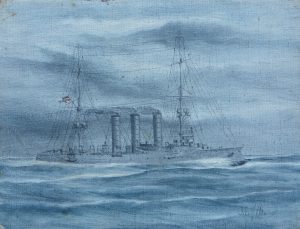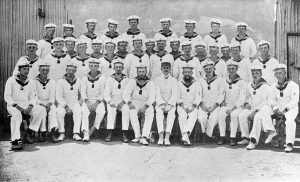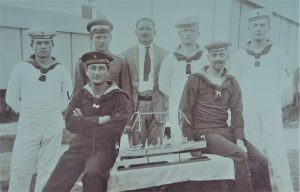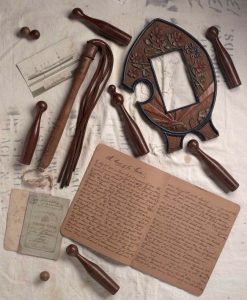- Author
- A.N. Other
- Subjects
- Ship histories and stories, History - WW1, WWI operations
- Tags
-
- RAN Ships
- HMAS Sydney I
- Publication
- March 2015 edition of the Naval Historical Review (all rights reserved)
By Walter Burroughs
The final voyage of SMS Emden and her eventual demise when cornered by HMAS Sydney is an action-packed drama which grips the imagination. Emden was a magnificent ship with a brilliant commander. Her story has been told numerous times from eye-witness accounts to official war histories and with many later commentaries. The historian A.W. Jose writing the Official History of the Royal Australian Navy 1914-1918says: ‘Whatever may be an estimate of the German Navy’s performance in the Great War, any navy might be proud of the Emden.’ The late Admiral Sir John Woodward (of Falklands fame) describes the last cruise of the Emden as both brilliantly successful and fatally doomed.
Despite all this information, difficulties are encountered in determining the exact complement of Emdenand, following her final fatal engagement, precisely where her officers and men were dispersed. This became of interest when attempting to identify characters associated with a small painting of Emden recently donated to the Naval Historical Society.

War is declared
Austria-Hungary declared war on Serbia on 28 July 1914. In far distant China ominous war clouds loomed over the German concession at Tsingtao, home port of Vice Admiral Maximilian von Spee’s East Asiatic Squadron. At this time the flag officer was at sea with most of his squadron, leaving the light cruiser Emden under her commander Korvettenkapitän Karl Friedrich Max von Müller as senior resident naval officer. On 31 July Emden was underway and the following day she received a radio message that the German Empire was at war with France and Russia. Emden commenced her remarkable war almost immediately as on 2 August she intercepted the Russian liner Rjasan and taking her as a prize returned to Tsingtao. Here the Russian ship was hastily converted to the armed merchant cruiser Cormoran.
On 6 August, the day prior to leaving Tsingtao for the final time, to bring her ship’s company up to strength she received three more officers, a junior officer, 13 technicians and 17 seamen. For a short time she also gained a Catholic priest. Five stokers who were suffering from dysentery were left behind in hospital, never to regain their ship. After coaling, Emden sailed to rendezvous with the remainder of the squadron at Pagan Island in the Marianas. Following a council of war it was agreed that Emden should proceed into the Indian Ocean and act independently there to interdict enemy shipping and trade. She was supported by her own collier and supply ship Markomannia with a German merchant crew.
Do the numbers add up?
When Emden made her final departure from Tsingtao she was near her wartime complement of 398 officers and men which included two European non-combatants, an officers’ cook and a barber, and three Chinese laundrymen. The cruiser sailed with 391 plus five non-combatants giving a total of 397 souls onboard. On reaching Pagan Island and later Angaur Island some crew exchanges were made where Emden received 15 additional officers and men and one officer and the priest were transferred out of her.
Emden was now uncomfortably overcrowded with 410 men onboard. This situation did not last for long as her successful encounter with thirty-two enemy and neutral ships resulted in many being taken as prizes, principally to ensure the adequacy of steaming coal. At one stage seven officers and 62 men were absent from Emden manning prizes. Prior to the Battle of the Cocos Islands 44 of her crew were manning the prize ships Buresk(16), Exford(15) and Pontoporos(13) which, with their valuable coal cargoes, became part of an increasingly important fleet train. Two of her crew were also aboard the consort Markomannia, one replacing the First Officer who captained a prize ship and the other to act as ship’s agent in an attempt to seek further supplies from neutral Dutch territory.
Emden’s remarkable exploits came to an end on 9 November 1914 after capturing and disabling the Cable and Wireless communications station on the Cocos Islands using a landing party of 50 officers and men. They were unable to regain their ship in time for the action when surprised by Sydney. Incredibly they escaped by capturing the island’s schooner Ayesha, making their way to the Dutch East Indies and from there eventually returning to Germany. This shows that at the time of her engagement with Sydney the Emden had a maximum of 314 (309 combatants) men available, 22 per cent below her wartime complement, which would have adversely affected her fighting capability. During the battle Emden suffered greatly with 136 men killed or dying of wounds, about 60 wounded and the remaining survivors badly affected by dehydration through lack of fresh water. By comparison Sydney’s casualties were light with four killed and 16 wounded. Following the battle Sydney intercepted the collier Buresk which scuttled herself, with Sydney taking her crew onboard.
We could speculate on what might have happened should the landing party have regained its parent in time for the battle. Emden’s renowned fighting efficiency might have improved but owing to the superiority of her adversary the ultimate outcome is unlikely to have changed. However the large number of Emden casualties could have significantly increased.
Emden survivors were also taken aboard Sydney. Even after the violence and intensity of the battle there was such respect for Commander von Müller that he was piped aboard Sydney and received by Captain Glossop who courteously declined to accept the vanquished warrior’s sword. An official communiqué on 11 November 1914 by the Secretary of the Admiralty announced that: ‘The Admiralty have given directions that all honours of war are to be accorded to the survivors of the Emden, and that the Captain and Officers will not be deprived of their swords’. As the war progressed attitudes hardened and it is unlikely that in all instances that these high ideals were maintained.
An account by Sydney’s medical staff of Emden prisoners says there were 70 wounded with 35 to 40 suffering seriously. To avoid overcrowding, all except the most seriously wounded were two days later transferred to the armed merchant cruiser Empress of Russia1.All survivors were then taken to Colombo with the wounded transferred to hospital. All Emden officers plus 25 seriously wounded patients (from both Emden and Sydney) remained in Sydney and these were transferred ashore when she reached Colombo on 15 November. Most of the wounded were taken to the Royal Naval sanatorium at Diyatalawa in the southern highlands until they recovered sufficiently to be shipped to Australia in 1915.
Those uninjured and medically fit were later taken in five different troop transports to Port Said and Suez. Here the POWs were transhipped to HMS Hampshire, initially for passage to England. Shortly after their departure a message was received redirecting Hampshire to Malta, where she arrived on 6 December 1914. This change of plan was brought about by the near hero status of the Emden crew which was considered unhealthy to British morale. Warrant Officers and below were imprisoned at St Clements and later Fort Salvatore in poor conditions. Officers were confined at Valetta’s Verdala Barracks. Lieutenant Fickentscher escaped in an open boat to Sicily where he was held prisoner but returned to Germany in October 1917. Commander Karl von Müller2was separated from his men in October 1916 and transferred to prison in England; here courtesy was not evident and he was poorly treated. He too escaped but was soon recaptured. In January 1918 in deteriorating health, suffering from malaria, he was released from custody under a prisoner exchange program and transferred to the Netherlands. The remainder of the prisoners in Malta appeared to be forgotten and did not return to their homeland for some considerable time. Those officers who could pay their own way were released in 1919 but the majority had to wait until the German Government was able to send a ship in 1920.
The sloop HMS Cadmus arrived at Cocos a week after the battle to collect the dead and commit them to the deep. She later returned and salvaged three of Emden’s guns, two of which are now in Sydney and one at Canberra’s National War Memorial. Cadmus also helped suppress a serious mutiny at Singapore which saw the temporary release of some Emden prisoners.
Australian internment arrangements
At the commencement of war the Australian Government made arrangements for the interment of suspect locally-domiciled enemy sympathisers who were mainly German and Austrian residents. In total 6,739 men, 67 women and 84 children were detained; this includes some 1,100 sailors, mainly from the merchant service. A large officially termed ‘concentration camp’ was established within the confines of Holsworthy Military Camp near Liverpool in New South Wales. Because of overcrowding, subsidiary and more lenient camps were established by recommissioning older gaols at Trial Bay north of Sydney and at Berrima to the south. The former, which could accommodate about 600 inmates, mostly accepted those with professional backgrounds, whereas the latter, which was only half the size, mainly held officers from the merchant and naval services. Captured German naval officers and men were sent to both Berrima and Trial Bay.

From available information we understand that 49 of the wounded Emden prisoners were subsequently transferred from Colombo to Australia for treatment and were interned at Holsworthy. Some Emden officers were amongst the initial cohort of prisoners who were transferred to Berrima in March 1915. The following month 26 of their compatriots, all in good health, from Exford, Pontoporos and Markomannia, arrived at Holsworthy.
On 12 October 1914 the colliers Pontoporos and Markomannia3 were captured off the neutral Dutch East Indies by HMS Yarmouth and taken to Singapore with the crews imprisoned at Tanglin Barracks. On 11 December a similar fate awaited Exford which was re-captured by the auxiliary cruiser HMS Empress of Japan near the western Dutch East Indies island of Sumatra and her crew transferred to the Empress of Japan and thence reunited with their shipmates at Tanglin Barracks. On 15 February 1915 the 5th Indian Rifles Regiment, garrisoned at Singapore, encouraged by their German prisoners mutinied and released the prisoners4.After ten days the mutiny was suppressed with the assistance of marines and bluejackets from British, French, Japanese and Russian warships. All were recaptured except Lieutenant Lauterbach (from Exford) who escaped to Java and thence to Germany via the United States. In April 1915 Emden prisoners in Singapore were transported to Sydney in the Burns Philp passenger/cargo ship Montoro and interned at Holsworthy.
In August 1915 some of these prize crews were dispersed between Trail Bay and Berrima5. The Berrima Historical Society has confirmed that one commissioned officer and six warrant officers were held at Berrima Goal. The Macleay Historical River Society has confirmed the names of 37 of the 38 Emden sailors held at Trial Bay Goal, which includes Assistant Paymaster Franz Bordeaux from Markomannia. Not all Emden men were lucky or fit enough to be sent to the ‘holiday camps’ and remained at Holsworthy throughout their internment. One sailor from Markomannia was shot and killed whilst allegedly attempting to escape from Holsworthy.
A new segregated Eastern Compound was built at Holsworthy and naval and military prisoners may have arrived here from Berrima and Trial Bay from May 1918. All other internees from these outstations were eventually returned to Holsworthy where they were shipped back to Germany in a total of nine ships which departed between April 1919 and June 1920. All Emden prisoners, together with a large number of civilian internees, departed from Sydney in SS Kursk on 29 May 1919 and arrived at Rotterdam 22 July 1919 from where they were taken by a special train to Germany.
Following representations from the German Government received via the Government of the then neutral United States of America, it was agreed that men classified as severely wounded and unfit for further military service might be repatriated to Germany. From an initial list of ten severely wounded prisoners five were eventually classified as fulfilling these criteria and embarked from Sydney on the hospital ship Kanowna on 4 July 1916 bound for London. A list of remaining Emden prisoners at Holsworthy dated 8 July 1916 shows 70 officers and men remained there.
The Emden Painting
One of our more senior members, David Mattiske, who served in the RAN during WW II and now resides in Queensland, recently contacted the Naval Historical Society about an Emden painting in his possession. In the 1960s when serving on the state executive of the Victorian Returned Services League (RSL), David was approached by an elderly lady (name unknown) with some material from Emdenin which her family showed no interest. The lady’s father had migrated from Germany in the 19th century and established a flourishing hairdressing and beauty parlour business at Melbourne’s Hotel Windsor.
Further enquires made with the Hotel Windsor confirm that a hairdressing salon seemingly with a German proprietor named Wannenmacher was extant in the early 1900s. Frederick & Anna Wannenmacher emigrated from Germany to Australia in 1855 with their descendants mainly to be found in Melbourne.
In 1915 it is assumed Mr Wannenmacher, or the then proprietor of the hairdressing business, was interned and sent to Holsworthy where he later met with Emden survivors whom be befriended. When they were separated, they presented him with some tokens of appreciation including a model of their ship and three small paintings. He was also given some diaries and other small artefacts which included a set of homemade wooden skittles.
The ship model which came boxed was thought to have been installed in the office of Sir William Hall, State President of the Victorian RSL. As no one showed any interest in the remainder of the memorabilia these were retained by David Mattiske. After WW I the unprecedented honour was granted to Emden veterans who so wished to add the suffix Emden to their family name. Over one hundred veterans accepted this honour including Prince Franz Joseph von Hohenzollern-Emden. Later David Mattiske met a grandson of one of the Emden survivors who lived in Adelaide. David gave one of his paintings of SMS Emden to this grandson who was overcome by emotion on receiving the gift.

Torpedoman Robert Mass to left of front row – NHS
About seven years ago David and his wife decided to downsize and were persuaded to sell the Emden artefacts to an antique dealer. These included a diary, some military documents and a set of skittles. All he retained was a photograph and two of the ship paintings. David has now presented a painting of Emden to our Society together with the attached photo of her sailors which is thought to show the ship model and possibly Mr Wannenmacher in the centre of the back row. The painting measures 18 x 24 cm and is initialled ‘J.L.’ and dated 1916. Records show only three Emden POWs in Australia whose names begin with ‘L’, which are Petty Officer Richard Lehnigk, Firemen Heinrich Laabs and Wilhelm Linnemann. As none of this group has a first name beginning with ‘J’ the mystery continues; could the artist have been from Markomannia?
The Mattiske Collection
In a surprising series of coincidences, about two years ago the Australian War Memorial purchased a small collection of Emden artefacts which have recently been lent to the Australian Maritime Museum and placed on display amongst an exhibition titled ‘The Australian Navy in WW I’. When visiting the Museum in January 2015 the author instantly recognised these artefacts as being similar to those mentioned as being sold by David Mattiske. They include a German military songbook from 1912, a Reich Pass or travel document, two photographs of Emden, a small purse, a pair of glasses, a hand carved decorative wooden picture frame, a set of skittles and a whip with the name Feukert carved into the stock. There is an Australian school exercise book with a four page account by an unknown author titled The Raid of the Emden. This appears to be from a German viewpoint but it is written in English.

The Victorian State Branch of the RSL has been unable to locate a model of the ship. This model is most likely that built by Torpedo-Oberheizer Robert Mass which won an award in an arts competition held at Holsworthy in 1916. It would be a wonderful conclusion to this exercise if the model was once again united with its contemporary artefacts. Perhaps one of our readers may know of its whereabouts.
The final numbers
As information taken from various authorities differs, it is not always possible to reconcile numbers. In August 1916 an Admiralty Prize Court in London heard a claim made on behalf of the crew of Sydney for prize money calculated at £5 for each man aboard Emden at the start of the engagement with Sydney. This was based on the premise that Emden had a full complement of 397, with 52 ashore with the Landing Party and 16 in the captured collier SS Exford, leaving 329 onboard at the start of the engagement and that 131 were killed in the battle and 214 captured after it. Later information, especially the considerable research conducted by the Emden-Family Association, indicates these numbers are inaccurate.
Information we have been able to find concerning Emden prisoners indicate 49 wounded were transferred from Colombo to Holsworthy. These were joined by 26 uninjured prize crews from Singapore. This provides a total of 75 which agrees with the official records confirming there were only 75 Emden prisoners held in Australian internment camps. There were two escapees that finally made their way to Germany plus 506from the Landing Party and 136 men were killed in action and/or later died of their wounds, leaving an estimated 150 imprisoned at Malta.
To mark the centenary of the Battle of Cocos Islands a commemorative ceremony was held at the Cocos Islands on 9 November 2014 in the presence of His Excellency the Governor General, General Sir Peter Cosgrove and His Excellency the Ambassador of the Federal Republic of Germany, Dr Christoph Müller. The Chief of Navy, Vice Admiral Tim Barrett, represented the RAN and the Deutsche Marine by Rear Admiral Henning Bess (Rtd) plus other naval participants and those representing the families of those lost in battle a hundred years past.
Notes:
- Numbers taken from HMAS Sydney’smedical staff records says 60 wounded and 100 fit prisoners plus 18 Chinese were transferred to the Empress of Russia but these are disputed by other authorities.
- Surprisingly Korvettenkapitän (Commander) Karl von Müller was not promoted to Kapitän zur See (Captain) until he returned to Germany in 1918; he resigned in ill health shortly afterwards and died on 11 March 1923, just short of his fiftieth birthday.
- The faithful Markomannia was scuttled when challenged by HMS Yarmouth and her crew taken aboard the warship.
- An unfortunate consequence of Great Britain declaring war on the Ottoman Empire on 5 November 1914 sowed seeds of conflict against Muslin states which has continued throughout generations. This also caused discontent amongst Muslims in northern India a situation which was fanned in 1914 by Germany, then a Turkish ally. The mutiny of Indian troops in Singapore is related to these events.
- The Berrima Camp opened in March 1915; Trial Bay opened in August 1915 and closed in July 1918 with Berrima not closing until August 1919.
- The fifty-strong landing party was later joined by another 4 men (two naval reservists and two merchant seamen) from SS Choising which ferried the Ayesha survivors on the final part of their voyage to southern Arabia.
Attachment: Emden Crew List of prisoners held in Australia




